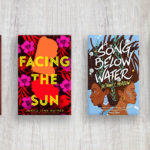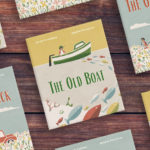Every March, we celebrate young artists of all forms – it’s Youth Art Month! There are so many ways to bring art into the classroom, and there are plenty of reasons we should, too.
As a secondary language arts teacher, I have found that student involvement within the arts (music, theater, and visual arts, as broad categories) often takes a nosedive as students enter middle or high school. There can be many reasons for this: budget cuts reduce course options and extracurriculars, students find it hard to fit electives into their schedules, or students simplify their busy lives by focusing on one activity at a time. Though students are lacking arts exposure as they go into upper grades, classroom teachers across subject areas can help bridge that gap. Here’s why you should consider doing so: an appreciation for the arts is a lifelong endeavor.
Art is part of the human experience, across all time and cultures. And experts say that it’s even more important to find ways to creatively explore during challenging times in our lives (can anyone say, “year-long pandemic”?). In recent years, there has also been a nation-wide shift in schools to address social-emotional learning. I can’t help but connect the dots that fostering creativity in our middle and high school students could be a natural path that guides them toward emotional intelligence. Plus, it’s a win-win for educators! We can sometimes access deeper levels of understanding and cognition in the process of creating, not to mention it gives us opportunities to scaffold or differentiate learning.
I challenge you this month to find ways your students can use their creativity to connect to your current subjects, topics, or lessons.
Here’s a list of my most successful arts-related activities that I use in my secondary ELA classroom:
Color Coding: If a character were a color, what color would they be? This simple idea can be the basis for valuable character analysis, though we want to provide guidance based on the psychology of visual perception (with ties to marketing, graphics, and illustrating). Show middle grade students popular examples by searching the web for “color-coded characters.” Discuss how colors can reflect a character’s motivations, energy, and emotions. Go deeper by referencing the text and the author’s descriptions. Older students may be able to add the use of shapes while steering clear of stereotypes. A great book to show the psychology of graphics and how we visually perceive shape and color is “Picture This: How Pictures Work” by Molly Bang.
Draw a Scene: Use details from a pivotal setting or moment in a book, and draw the scene as it is described, adding your own creative flair. Many deliberate decisions need to be made to help reflect an understanding of the scene and to explain its importance. The use of black charcoal may indicate a moody angst or fear, while other color palettes might reflect other moods. It can be fun to see how different student artists imagine the same scene.
Costume Design: Every movie and TV show we watch has a team of costume designers who build a character’s “look.” Similarly, students can design one signature outfit for a character from a novel. Thought should be given to style, time period, fabrics, where the items are from (brand name? second-hand?), color choices, accessories, etc. I had an engaging classroom discussion about individuality versus conformity when we designed costumes for the Greasers in S.E. Hinton’s “The Outsiders.” This activity allowed us to organically dig deeper into this major theme of the novel.
Monologue: Students with theater background may be drawn to this one: compile all the dialogue from one character throughout a book to create a monologue, then present it to the class as if you’re auditioning for a play. We saw the villain, Madame Defarge, from Dickens’ “A Tale of Two Cities” in an entirely new light because of this project, and had a deep follow-up discussion about narrative perspective and its effect on the reader.
Artifacts: Using found objects, supplies, and craft materials, create a “museum” dedicated to a novel. What artifacts would be present, and what is each item’s significance? “The Great Gatsby” museum would surely have a cream-colored car, a green dock light, and a salmon-pink suit. This is a great activity to address symbolism, characterization, or as a whole-novel review.
Frozen Scene: Call your photography students to work while you study a famous play together. The photographer’s job is to “freeze” the actors in a scene at its height of emotion, to create a “still” photo that could be used to advertise the play. Sprinkle in conventions of theater like blocking and lighting. Post these photos in your classroom as a reminder of the major events in the play, which will help aid a review later. This activity is especially useful if you don’t have time to act out entire plays as a class, or if you want to include students who are reluctant to act or read in front of their peers.
30-Second Soundtrack: Find a song that appropriately connects to a character or event, or divide by chapters. Students should make connections with lyrics and mood, and present the “best” 30 seconds as a pitch for the upcoming movie’s soundtrack.
Musician’s Choice: Ask your student musicians how they could use their talents to connect to your subject matter. Students could write parodies to recap the plot of a book or the characters and their problems, write original songs they sing or play, or write a theme song for a movie version of the book (with their own musical talent or an app like GarageBand).
Board Game: My science fiction book club students created board games to go with their books. This project took a lot of planning and guidance, but the outcome was amazing. If you don’t have time to do the entire project, choose a piece of it. The boards reflected the setting somehow, even if only in color choices and style. Students created game pieces in unique ways, too: custom LEGO characters, polymer clay, origami, and even 3D printed pieces (hint: what an excellent cross-curricular idea with your art or STEM departments!). A board game works great for adventure, mystery, or fantasy books, too.
Cover Art: Create a new cover for a book. Again, students should be looking at incorporating symbols, characters, or major events, with the goal to draw in your audience and get them to read the book. It can be fun to take a look at a classic novel to see how many reiterations there have been of the cover art. There may be a natural connection to a variety of forms of art here, too; with so much creative work published on the internet, checking out fan art can create new points of discussion.
Ask Your Students: My all-time favorite project with Rick Riordan’s “The Lightning Thief” was the brainchild of one of my students. They created their own demigods by imagining that a Greek god or goddess had a child with a mortal celebrity from any time in history. What would that child look like, and what would their special abilities be? Even students who didn’t consider themselves creative or artistic loved this project, and it was a great way to review the major Greek gods. Ask your students, “How can we get creative with this topic?” and see what ideas arise.
With any creative adventure in the classroom, allow some freedom paired with a low-stress environment, and reward effort and the ability to explain their choices, rather than artistic talent alone. Some students may need to use templates to boost their confidence. For example, with the demigod project above, I provided body outline templates that I found online.
Happy creating!






